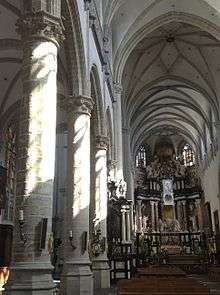St. Andrew's Church, Antwerp
St. Andrew’s Church (Dutch: Sint-Andrieskerk) is a Catholic church in Antwerp built in the 16th century. Its exterior is mainly characterised by a late-Gothic style while its interior is predominantly executed in Baroque style. It is the parish church of the Parish of St. Andrew’s. During the nineteenth century the St. Andrew's Parish was known as the parish of misery as it was by then mainly populated by poor people.
History
Construction of the church commenced in the 16th century by Augustine friars who had built a convent with a chapel at the same location in 1513. Johannes van Mechelen of Osbach initiated 1508 the foundation of the monastery. The Augustinians decided to build a church there in 1514 but when they were accused of Lutheran sympathies the grounds were taken from them. In 1527 the site was parceled to finance the building of the church.[1] The former convent chapel was expanded and then consecrated as a parish church in 1529.[2] The church was later expanded with a tower in the west and a transept.[1]

In 1549, city politician and ecclesiastic Nicolaas Beukelaer endowed the church with a prebendary to assist with the administration of the church.[3]

During the Beeldenstorm of 1566 the church interior was destroyed. The church was divided up between Catholics and Calvinists in 1568. In 1579 the division was made permanent through the construction of a dividing wall. In 1581 the Calvinists denied the Catholics access to the church and demolished the part of the church that was assigned to the Catholics. After the Fall of Antwerp in 1585 and the defeat of the Calvinists, the church was returned to the Catholics. The church was decorated with new altar pieces by leading Antwerp artists such as Otto van Veen, Maerten de Vos and one of the many members of the Francken family who lived nearby.[1]
In the middle of the 17th century a large construction campaign was started. First an arch was built over the nave and the transept destroyed by the Calvinists was rebuilt and expanded. In subsequent years, the church was further expanded with a choir with two bays and later with two chapels. In 1755 the tower of the church collapsed and a new Baroque tower designed by Engelbert Baets was constructed inside the western bay of the nave.[1]
During the French revolutionary occupation starting in 1794, the church was saved by the decision of the priest Jan-Michiel Timmermans to swear allegiance to the French regime. The church lost some of its silver, the triptych by Marten de Vos and the statue of St. Peter by Artus Quellinus I to confiscation by the French. After the Concordat of 1801 between Napoleon and the Pope, the church became again the parish church of the Parish of St. Andrew’s in 1802 and the confiscated St. Peter statue was returned. It would take longer to recover the Marten de Vos triptych which finally ended up in the Museum of Fine Arts, Antwerp.[1]
In the early 19th century, more Baroque furniture and paintings, mainly retrieved from churches and monasteries destroyed or closed during the French occupation, were added to the church. The church suffered major damage during the Dutch bombardment of Antwerp in 1830 and burnt down partially.[4] From 1863 the church was fitted out with new stained glass windows in Gothic Revival style. The stained glass windows on the north side were destroyed on 2 January 1945 through the explosion of a German V-1 flying bomb. These were later replaced by windows designed by Jan Huet.[1]
Church art

The church contains many valuable artefacts and art works. It holds a monument erected in memory of Mary, Queen of Scots, by Robert and Jan De Nole (1620) with a portrait painted on copper by Frans Pourbus the Younger (1569-1622).
There are many paintings by Antwerp's leading painters such as Ambrosius Francken (1544-1618), Otto van Veen (1560-1629), Hendrick van Balen (1575-1632), Maarten Pepyn (1575-1643), Frans Francken the Younger (1581-1642), the workshop of Anthony van Dyck (1599-1641), Erasmus Quellinus the Younger (1607-78), Theodoor Boeyermans and Karel Verlat (1845–57).
Many of the church's furnishings are distinctly in the Baroque style, as earlier pieces had been destroyed during the 16th century Beeldenstorm. The church furniture is made by some of the leading sculptors of their time. The High Altar was originally from the former St. Bernard Abbey and the choir stalls from the convent of the Augustinian friars and are both the work of Pieter Verbrugghen I (1615–68). The sacrament altar and confessional in the Our Lady's Chapel are by Lodewijk Willemsens (1630-1703). The Holy Cross Altar is by Cornelis van Mildert (1664). The St. Anna Shrine is by Jan van den Cruyce (1674). The Our Lady Altar was made by Peeter Vervoort and father and son Willem Kerrickx (1729). The organ case is the work of Engelbert Baets (1779) and the pulpit is by Jan Baptist Van Hool and Jan Frans van Geel (1821).[4]
Many of the church's features were restored in the 1970s. In 2001, the church's statue of the Virgin Mary dated 1585 (referred to as Our Lady of Succour and Victory) was dressed in modern clothes designed by local fashion designer Ann Demeulemeester to commemorate Antwerp's "Fashion Year".[5]
References
- Rudi Mannaerts, Antwerpen, Sint-Andrieskerk - Geschiedenis & Beschrijving Archived 2013-09-21 at the Wayback Machine (in Dutch)
- Innovation and Experience in the Early Baroque in the Southern Netherlands: The Case of the Jesuit Church in Antwerp by Piet Lombaerde (Brepols Publishing, 2008)
- Contemporaries of Erasmus: a biographical register of the Renaissance and Reformation, vol. 1, A-E by Peter Gerhard Bietenholz (University of Toronto Press, 1985)
- De Inventaris van het Bouwkundig Erfgoed, Parochiekerk Sint-Andries (ID: 6299) (in Dutch)
- Early Modern Women in the Low Countries: Feminizing Sources and Interpretations of the Past by Susan Broomhall & Jennifer Spinks (Ashgate Publishing, 2011)
External links
| Wikimedia Commons has media related to Sint-Andrieskerk (Antwerp). |